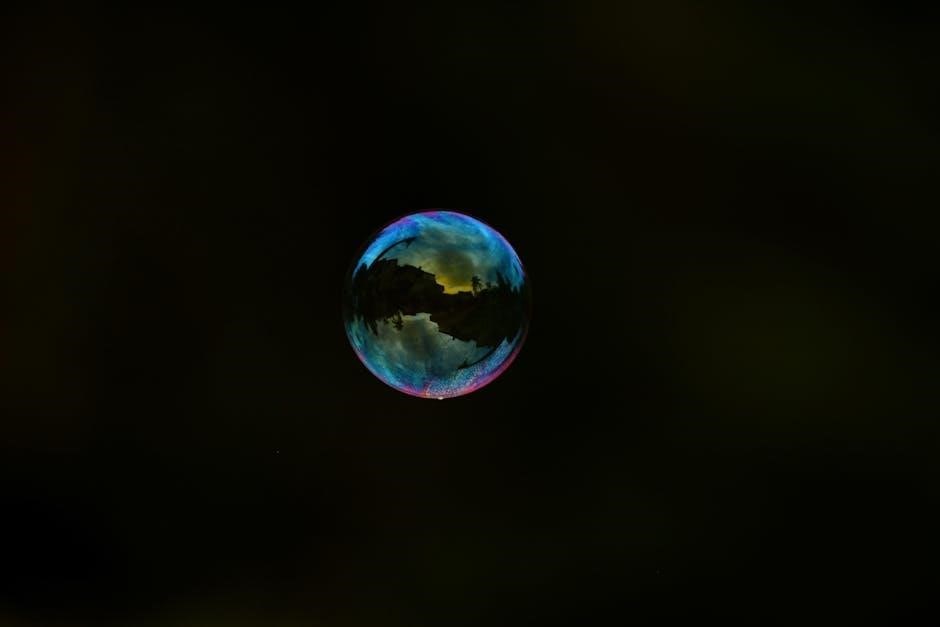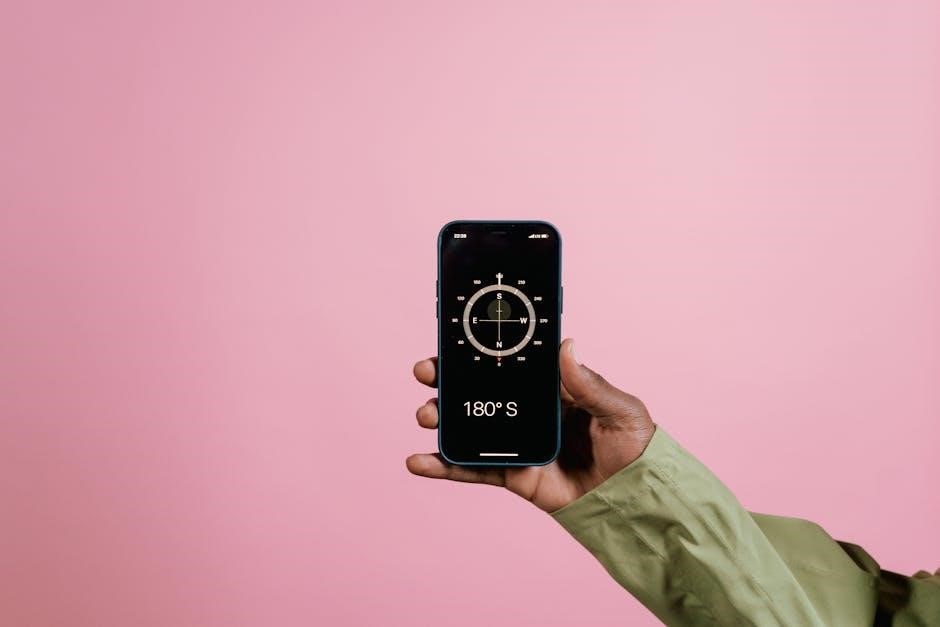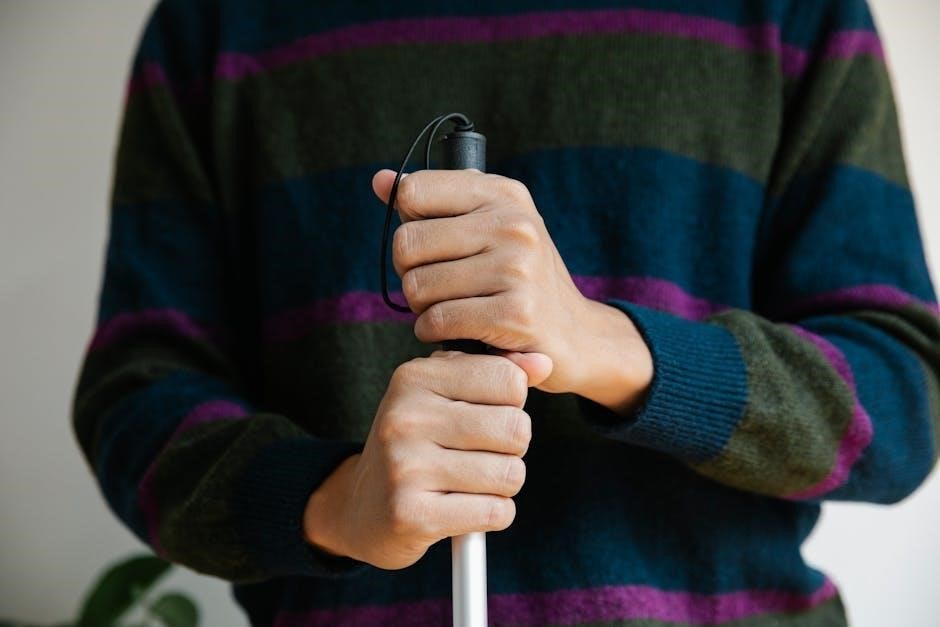The Nikon D5200 is a versatile DSLR camera featuring a 24.1 MP sensor, ISO 100-6400, and 39-point autofocus. Ideal for enthusiasts and professionals, it delivers stunning image quality.
Overview of the Camera
The Nikon D5200 is a mid-range DSLR camera designed for photography enthusiasts and professionals. It features a 24.1 MP DX-format CMOS sensor, delivering high-resolution images with excellent detail. The EXPEED 3 image processor enhances performance, offering fast operation and improved noise reduction. With an ISO range of 100-6400 (expandable to 25600), the D5200 excels in various lighting conditions. It also boasts a 39-point autofocus system for precise subject tracking. The camera supports full HD video recording at 1080p and includes a vari-angle 3-inch LCD screen for flexible composition. Built with a durable design, the D5200 is lightweight yet robust, making it ideal for both beginners and advanced photographers. Its intuitive controls and customizable settings provide a seamless shooting experience;
Quick Start Guide
Unbox the Nikon D5200 and ensure all accessories, including the battery, charger, and memory card, are included. Charge the battery fully before first use. Insert the memory card into the camera, ensuring it is compatible and formatted. Attach the provided lens or your preferred Nikon-compatible lens. Power on the camera and navigate to the setup menu to set the date, time, and language. Familiarize yourself with basic controls, such as the mode dial, shutter button, and navigation buttons. Set the camera to Auto Mode for an easy start; Review the user manual or guide for advanced features and customization options. Experiment with different settings to enhance your photography experience. Always refer to the manual for troubleshooting or detailed instructions.

Key Features of the Nikon D5200
The Nikon D5200 boasts a 24.1 MP APS-C sensor, ISO 100-6400, 39-point autofocus, and Full HD video recording. It offers compatibility with Nikon lenses and accessories, ensuring versatility for enthusiasts and professionals alike.
Sensor and Image Quality
The Nikon D5200 features a 24.1-megapixel APS-C CMOS sensor, delivering high-resolution images with excellent detail and clarity. This sensor is designed to capture a wide dynamic range, ensuring rich tones and vibrant colors. Whether shooting in bright sunlight or low-light conditions, the D5200 produces images with minimal noise and impressive sharpness. Its ability to handle various lighting scenarios makes it an excellent choice for both professional photographers and enthusiasts. Additionally, the sensor supports Full HD video recording, allowing users to capture stunning footage with precise color reproduction and smooth transitions. This combination of high-quality sensor technology and advanced image processing ensures the D5200 stands out in its class.
ISO Range and Noise Performance
The Nikon D5200 offers an ISO range of 100 to 6400, extendable to 25600 in Hi mode, making it versatile for various lighting conditions. At lower ISO settings, the camera produces clean images with minimal noise. As ISO increases, noise becomes more noticeable, particularly in shadows, but the D5200 handles it well compared to its peers. The camera’s noise reduction system ensures that images remain usable even at higher ISOs, though fine details may soften slightly. For best results, keeping ISO below 800 is recommended for optimal image quality. This balance of sensitivity and noise control makes the D5200 suitable for both low-light and bright environments, offering photographers flexibility without compromising image integrity.

Autofocus System
The Nikon D5200 features the Multi-CAM 4800DX autofocus sensor, offering fast and precise focusing performance. With 39 autofocus points distributed across the frame, it ensures wide coverage and accurate subject tracking. The camera supports multiple autofocus modes, including AF-S (Single Servo AF) for stationary subjects, AF-C (Continuous Servo AF) for moving subjects, and AF-A (Auto Servo AF), which automatically switches between AF-S and AF-C. The Scene Recognition System enhances autofocus accuracy by analyzing the scene, while Face Detection prioritizes focus on human faces. These features make the D5200 suitable for capturing sharp images in various scenarios, from portraits to dynamic action shots. Customization options allow photographers to tailor autofocus settings to their preferences, optimizing performance for different shooting styles.

Video Recording Capabilities
The Nikon D5200 offers Full HD video recording at 1080p resolution, with frame rates of 24p, 25p, 30p, 50p, and 60p. It supports manual controls during video recording, allowing adjustment of aperture, shutter speed, and ISO for creative flexibility. The camera also features Live View for precise framing and focusing. An external microphone jack enhances audio quality, reducing wind noise and capturing clearer sound. The D5200’s autofocus during video recording uses contrast-detect AF, providing smooth transitions for stationary or slow-moving subjects. Videos are recorded in H.264/MPEG-4 format, with a maximum file size of 4GB or a recording time of 29 minutes and 59 seconds. These features make it a versatile tool for both casual and enthusiast videographers.
Getting Started with the Nikon D5200

Getting started with the Nikon D5200 involves unpacking, charging the battery, and inserting a memory card. Set up the camera for first-time use.
Unpacking and Initial Setup
Begin by carefully unpacking the Nikon D5200 from its box. Check for all included accessories, such as the camera body, kit lens, rechargeable battery, battery charger, neck strap, USB cable, and user manual. Inspect the camera for any visible damage. Attach the lens by aligning the mounting indexes and turning it clockwise until it clicks. Secure the neck strap to the camera’s strap eyelets for safe handling. Open the memory card slot on the side of the camera and insert a compatible SD, SDHC, or SDXC card. Insert the provided EN-EL14 battery into the charger and plug it into a power source. Once charged, insert the battery into the camera. Turn on the camera to begin the initial setup process, which includes selecting your language, setting the date and time, and choosing other initial preferences.
Charging the Battery and Inserting the Memory Card
To charge the Nikon D5200’s battery, use the provided EN-EL14 rechargeable lithium-ion battery and MH-24 charger. Insert the battery into the charger, ensuring the terminals align correctly. Plug the charger into a power outlet and wait until the charging indicator turns green, indicating the battery is fully charged. Once charged, remove the battery from the charger and insert it into the camera’s battery compartment, located at the bottom of the camera. For the memory card, open the memory card slot on the side of the camera. Insert a compatible SD, SDHC, or SDXC card with the label facing the correct direction. Gently push the card until it clicks into place. This ensures your camera is ready for use with sufficient power and storage.
Setting Up the Camera for the First Time
After inserting the battery and memory card, turn on the Nikon D5200 by pressing the power switch. The camera will automatically enter setup mode. Use the multi-selector (directional pad) to navigate through the menu. First, select your language and press OK; Next, set the date, time, and timezone, ensuring the information is accurate for proper file stamping. Choose your desired image quality settings, such as RAW or JPEG, using the QUAL button. Set the autofocus mode by pressing the AF-mode button and using the command dial; Finally, format the memory card by selecting Format in the setup menu to ensure optimal performance. Once completed, the camera is ready for use.

Shooting Modes Explained
The Nikon D5200 offers various shooting modes, including Auto, P, S, A, and M, catering to beginners and advanced photographers seeking creative control and precision.
Understanding Auto Modes
The Nikon D5200 features several Auto modes designed to simplify photography for beginners or those who prefer convenience. The Auto Mode automatically adjusts settings like aperture, shutter speed, and ISO for optimal results in various lighting conditions. Auto (Flash Off) disables the flash, ideal for situations where flash is not allowed or desired. The Scene Auto Selector analyzes the scene and selects the most appropriate mode from pre-defined options like Portrait, Landscape, or Close-up. These modes eliminate the need for manual adjustments, making it easy to capture high-quality images without extensive knowledge of camera settings. However, they offer limited creative control, making them best suited for casual shooting.
Exploring Manual and Semi-Manual Modes
The Nikon D5200 offers manual and semi-manual modes for photographers seeking greater creative control. Manual Mode (M) allows full control over aperture, shutter speed, and ISO, enabling precise adjustments to capture unique effects. Aperture Priority Mode (A) lets you set the aperture, while the camera adjusts the shutter speed, ideal for controlling depth of field. Shutter Priority Mode (S) lets you set the shutter speed, with the camera adjusting the aperture, perfect for freezing or blurring motion. These modes cater to advanced users who want to experiment with lighting, focus, and composition, making them essential for creative photography. They provide flexibility and precision, allowing photographers to achieve their artistic vision.
Using Custom Shooting Modes
The Nikon D5200 allows you to save custom shooting settings, enabling quick access to your preferred configurations. Custom Shooting Modes (U1 and U2) are accessed via the mode dial, providing instant recall of saved settings. To use this feature, adjust settings like aperture, shutter speed, ISO, and white balance in manual or semi-manual modes, then save them under Setup Menu > Save User Settings. This is ideal for frequently used setups, such as portrait or landscape photography. Custom modes streamline your workflow, saving time and ensuring consistency in your shots. They are a powerful tool for photographers who work in specific conditions or styles regularly.
Mastering the Menu Functions
The Nikon D5200 offers a comprehensive menu system with Playback, Shooting, Setup, Retouch, and My Menu options. These menus allow you to optimize camera settings, customize functions, and enhance your shooting experience efficiently.
Navigating the Playback Menu
The Playback Menu on the Nikon D5200 allows you to review and manage your photos and videos. Key features include delete, rotate, and slide show options. You can also apply filters like monochrome or sepia to images during playback. Additionally, the menu offers tools for protecting images from accidental deletion and rating photos for easier organization. Use the multi-selector to navigate through your files and access these functions quickly. The Playback Menu is essential for reviewing your work and making quick adjustments without entering deeper menu settings.
Exploring the Shooting Menu
The Shooting Menu on the Nikon D5200 offers a wide range of options to customize your photography experience. Here, you can adjust settings like image quality, white balance, and autofocus modes. Choose between RAW, JPEG, or RAW+JPEG formats for file storage. Adjust white balance presets or set a custom value using the PRE option. The menu also allows you to enable or disable features like Active D-Lighting for better contrast in high-dynamic-range scenes. Additionally, you can configure autofocus modes, such as AF-S (single servo) or AF-C (continuous servo), depending on your subject. These settings enable you to tailor the camera’s performance to your shooting style and conditions, ensuring optimal results in various scenarios.

Understanding the Setup Menu
The Setup Menu on the Nikon D5200 is where you can configure the camera’s basic operational settings; Here, you can adjust the monitor brightness and color balance to match your viewing preferences. Language and time zone settings are also accessible, ensuring the camera’s clock is accurately set. Additionally, this menu allows you to format memory cards, reset shooting settings to default, or perform a sensor cleaning to remove dust. You can also enable or disable features like GPS and wireless communication if using optional accessories. Furthermore, the Setup Menu provides options for updating firmware to ensure the camera operates with the latest features and improvements. These settings are essential for maintaining and personalizing your camera’s functionality.
Customizing the Retouch Menu
The Retouch Menu on the Nikon D5200 offers a variety of tools to enhance and edit your photos directly on the camera. You can apply options like D-Lighting to balance contrast, Red-eye correction to fix portraits, and Distortion control to adjust lens aberrations. The menu also includes Filter effects, such as Skylight and Warm filters, to add creative touches. Additionally, you can Trim images to crop or resize them and Convert to black and white for a classic look. These edits are non-destructive, preserving the original file while saving a new copy. This feature allows you to refine your photos without needing a computer, making it a convenient option for quick adjustments.
Utilizing My Menu

The Nikon D5200’s My Menu feature allows you to create a personalized list of frequently used settings for quick access. This customization option streamlines your workflow by letting you add up to 20 menu items that you use most often. To customize My Menu, navigate to the Setup Menu, select My Menu, and choose items from the available options. You can also reorder or remove items as needed. Accessing My Menu is simple—press the menu button and select it from the main menu. This feature saves time, especially during shoots, by reducing the need to navigate through multiple menus. Your customizations are saved automatically, ensuring your preferred settings are always within easy reach.

Customizing Your Shooting Experience
The Nikon D5200 allows you to tailor settings to your personal preference, enabling a more intuitive and efficient workflow. Custom settings provide quick access to frequently used options, while features like bracketing and HDR let you refine your images and expand creative possibilities.
Adjusting Custom Settings
Custom settings on the Nikon D5200 allow you to personalize camera functions to suit your shooting style. Access the Custom Setting Menu via the camera’s menu system. Here, you can modify settings such as autofocus modes, metering patterns, and exposure compensation. For instance, you can adjust the AE-L/AF-L button to prioritize autofocus over exposure lock. Additionally, the Custom Settings enable you to define personal preferences for features like bracketing intervals or the behavior of the shutter release. These adjustments streamline your workflow, ensuring that the camera operates in a way that aligns with your creative vision. By tailoring these settings, you can enhance your shooting experience and achieve consistent results.
Using Bracketing and HDR
Bracketing on the Nikon D5200 allows you to capture multiple shots at different exposure levels, which can be merged later to create images with enhanced dynamic range. The camera can shoot up to three frames at intervals of ±1/3, ±2/3, or ±1 EV. This is particularly useful for high-contrast scenes. To activate bracketing, go to the Shooting Menu, select Bracketing, and choose your desired settings. For HDR, while the D5200 doesn’t have an in-camera HDR mode, you can use bracketed shots in post-processing software to create HDR images. This technique ensures detailed highlights and shadows, making it ideal for landscapes or backlit subjects.
Working with Accessories
The Nikon D5200 supports a variety of accessories, including lenses, external flashes, and remote shutter releases, enhancing functionality and flexibility for photographers.
Compatible Lenses and Accessories
The Nikon D5200 is compatible with a wide range of Nikon F-mount lenses, including AF-S, AF, and DX lenses, ensuring versatility for various shooting needs. The camera is bundled with an 18-55mm VR kit lens, but users can explore other options like wide-angle, telephoto, or macro lenses for enhanced creativity. Additionally, the D5200 supports external accessories such as flashes, remote shutter releases, and battery grips. These accessories can improve functionality, reduce camera shake, and extend shooting capabilities. When selecting lenses or accessories, ensure compatibility with the D5200’s specifications for optimal performance.
Using External Flashes and Remote Shutter Release
The Nikon D5200 supports external flashes, which enhance lighting control and reduce harsh shadows. Compatible flashes like the SB-400 or SB-700 can be mounted on the hot shoe or triggered wirelessly. For remote operation, the MC-DC2 remote shutter release minimizes camera shake, ideal for long exposures or macro photography. The camera also supports wireless remotes, allowing hands-free shooting. Additionally, the D5200’s self-timer mode can be used with external flashes or remotes. Proper synchronization ensures balanced lighting and sharp images. Using these tools expands creative possibilities and improves photo quality in various lighting conditions.

Troubleshooting Common Issues
Common issues like camera freeze or blurry images can often be resolved by checking battery levels, memory card functionality, and lens connections. Resetting settings or updating firmware may also address problems.
Resolving Common Camera Issues
Common camera issues with the Nikon D5200 can often be resolved with simple troubleshooting steps. If the camera freezes, try resetting it by turning it off and on or removing the battery for a few seconds. Blurry images may result from improper autofocus settings or lens contamination—clean the lens with a soft cloth and ensure autofocus is set correctly. Memory card errors can be fixed by formatting the card in the camera or using a card reader. Additionally, updating the camera firmware to the latest version can resolve software-related problems. Always ensure the camera is properly charged and lenses are securely attached to avoid operational issues.
Understanding Error Messages
Error messages on the Nikon D5200 are designed to guide users in resolving issues quickly. Common messages include “ERR” for general errors, “CARD” for memory card issues, and “fEE” for autofocus problems. Other messages like “CHAKr” indicate problems with the lens or camera body. Always refer to the user manual for specific error code meanings. Many errors can be resolved by turning the camera off and on, cleaning the lens or memory card, or reinserting the card. If persistent, update the camera firmware or reset to factory settings. Understanding these messages helps maintain optimal performance and prevents potential damage to the camera.

